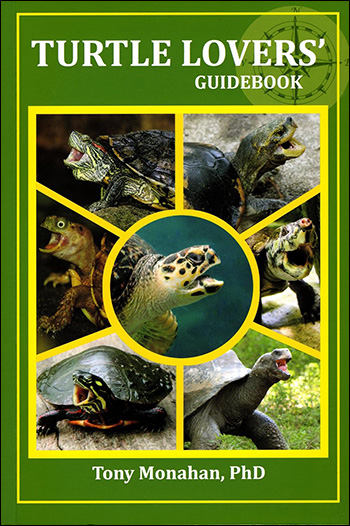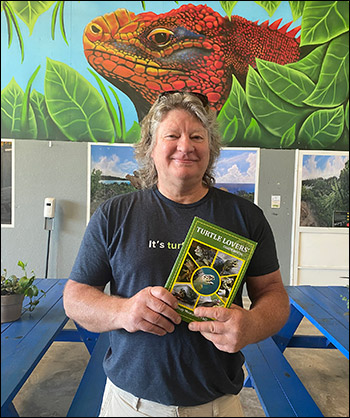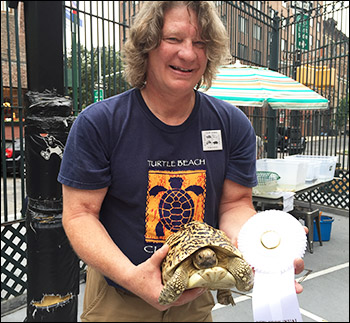

















|

Turtle Lovers' Guidebook: Author Tony Monahan's Fascination with Turtles Becomes Life Mission
By Andrea Marvin
Author Tony Monahan is an artist, writer, and educator at the City University of New York.
Monahan has always had a fascination with turtles, and his curiosity about them has evolved into a life mission. A photography project Monahan worked on while exploring the topic of stress management for a class lecture evolved into a quest to spread awareness about the magnificent creatures.
Over the course of four years, Monahan visited 164 public sites across the country to photograph different turtle species and write about organizations that are striving to protect them.
The culmination of his journey resulted in his book, Turtle Lovers' Guidebook, which explores zoos, aquariums, and nature centers where people can visit and see numerous turtle species.

For each site in the Turtle Lovers' Guidebook, a list of the types of turtles found at that location is provided, along with a QR code that allows readers to access the website directly. The guidebook is easy to navigate and has over 500 photographs that showcase more than 200 turtle species and subspecies.
The Turtle Lovers' Guidebook can be used as part of a travel guide for a trip and is also suitable for readers with an interest in turtles who want to learn more about them.
Turtles are one of the most vulnerable groups of animals on earth, with almost half of them endangered and several species extinct in the wild. Author Tony Monahan explains how he aims to raise awareness about the challenges turtles face while also offering readers hope.
The Turtle Lovers' Guidebook lists rescue and rehabilitation centers for turtles, as well as organizations persevering with conservation efforts. One of them is the Turtle Survival Alliance, a leading turtle conservation group that maintains a captive breeding colony to protect and restore turtle populations.
During an interview with author Tony Monahan, he reveals how his overall journey in creating this book has inspired him to write and spread awareness about turtles full-time.
His photography, paintings, and paper structures have always involved turtles, and this mission he strives for in his artwork is now being carried out in his books.
Monahan plans to continue writing about turtle species worldwide to inspire, educate, inform, and engage readers.
When did your fascination with turtles begin?
My initial attraction to turtles was artistic. I was artistically creative as a child, and my artwork features turtles. I'm fascinated by the shell, the colorings, and its patterns.
As a kid, my family moved around a lot, and I didn't have a dog or a cat, but my mom allowed me to have small turtles as pets. I had a fascination with them and read turtle books and collected turtle T-shirts.
I teach health at the City University of New York and was asked by my boss to teach a class on stress management. In a nutshell, stress management is doing what you love. I took that to heart, so I bought a nice camera and began visiting places to take pictures of turtles.
As I became more interested in it, I started looking up where else I could see turtles and began searching for different zoos, marking the start of the travel part of my journey.
When I visited aquariums, I learned about their history and discovered that turtles were beloved. I would see people and kids get excited about turtles and realize it wasn't just me.
That said, I thought there should be a guidebook for turtle lovers. So, four years later, I published the Turtle Lovers' Guidebook.

After visiting hundreds of zoos and aquariums to see turtles, what did you learn from the experience?
I learned a great deal during this project. There are around 350 different species of turtles worldwide. I might not be able to see them all, but I'm working on it.
I also learned that they are the most vulnerable group of animals on earth. Almost half of them are endangered, and several species are extinct in the wild.
However, some can still be seen at zoos and aquariums around the country.
Based on your research for the book, what are the leading causes of turtle populations becoming depleted?
There are four main reasons. Habitat loss is a significant concern, as is pollution. Turtles are also hunted for food and traditional medicine. Lastly, the pet trade for turtles is huge.
In general, the pet trade is one of the top illegal trade activities in the world, next to guns and drugs.
I am a positive person, though, and I wanted to highlight the good aspects, touching on organizations and projects that make a difference.
I make note of the danger and the plight of turtles around the world, but I wanted to show that there is hope.
How would you describe the layout of Turtle Lovers’ Guidebook?
The central part of the book focuses on public sites, including zoos, aquariums, and nature centers that are accessible to the public. I want the reader to be actively involved.
For each site in the book, basic information and a QR code are provided, allowing readers to access the site's website directly. I keep my descriptions concise, typically around 80 words.
There are nice photos that show the different turtle species, and each site has a listing of the turtles spotted at that particular location.
I created some rules while doing research for my book. The first one I established is called the Steinhart Rule, named after the Steinhart Aquarium in San Francisco.
It's a gorgeous place, and I didn't want to exclude it from my book. However, there were only five species when I visited the aquarium. In other areas, they sometimes had more, sometimes less.
So, my Steinhart Rule is the sites need to have five species or more to get a visit. They must have healthy animals in clean enclosures and a conservation approach.
There are some places I've visited that have plenty of turtles, but I just didn't like the situation. Those places are not in my book.
Regarding the order in the book, the public sites are organized by region: East, South, Central, and West. It's like a travel guide.
I tried to line up these places on either north-to-south or east-to-west routes so you can take a little road trip and visit them.
In addition to these public sites, I wanted to list the rescue and rehabilitation centers for turtles.
Toward the end of the book, I provide a list of all the various projects and programs underway to help save the turtles. Although these animals are in trouble, numerous organizations are doing great things to help save them.
If readers want to get involved, I provide information on places to visit, organizations to join or volunteer with, and rescues where you can adopt one.

During your research process, did you discover a particular organization that you feel is doing great work?
The Turtle Survival Alliance is the leading group in the United States and around the world, and the organization is doing extraordinary things. They have multiple projects underway and maintain an assurance colony.
With an assurance colony, you get near extinct animals and attempt to propagate and grow the population, hoping that someday they can be returned to their native lands.
The Turtle & Tortoise Preservation Group is also a remarkable group of individuals nationwide who are actively working to breed endangered turtles by coordinating efforts across the country and sharing their resources to increase the populations of some of these vulnerable animals.
Further, there is a Turtle Conservancy that does international efforts.
Those are the three main groups to which I belong. Again, before I started this project, I knew nothing about any of this, but now I belong to them. I've spoken at their conferences.
I'll be speaking again this summer, and I look forward to being part of these groups for the rest of my life.
Why would you say it's essential to pay attention to the challenges turtles are facing and support conservation efforts?
Turtles are instantly recognizable and have been around for 230 million years on Earth, dating back to a time before the dinosaurs. They are gorgeous and carry around these amazing shells that provide protection.
Turtles are not a nuisance and do not bite. Snapping turtles will only bite if they feel threatened or in danger. But generally, if you come across a turtle, it's not going to attack you. They play a vital role in the ecosystem.
I've found, from just the last few years, that being part of these groups, hundreds of thousands of people love turtles. We don't want to see different animals go extinct.
The Turtle Survival Alliance has the slogan ‘zero turtle extinctions.' We're going to keep these creatures alive. I'm on board with that.
Who is your audience for the book?
The book is intended for individuals interested in turtles. It can also be used as part of a travel guide for those going on a trip or for people who love turtles but are not experts.
Most turtle books fall into two distinct categories. You have natural history books, such as those on turtles of the world or specific turtle species. You also have pet turtle books that focus on how to care for them as pets.
However, there is no book where you can travel around and see them.
There are butterfly and birding-type books that show you where to see these animals and insects, but nothing like this combines a travel guide with the opportunity to see them in person.
I wanted to do that because I noticed that kids and other people pay heightened attention when they see turtles.
There are so many different types of species. And you’re not going to see many of these species in the wild.
For example, The McCord’s Box Turtle from China is extinct in the wild, but you can see them at the Detroit Zoo or the Saint Louis Zoo. You can see them at the Philadelphia Zoo and lots of other places because these zoos care for them.
It is that kind of thing where this is a special animal that you might not ever see unless you go to these particular places.

For future projects, do you plan to expand on this topic?
This project has opened my eyes. I have decided to retire from my job as a professor in a year to dedicate the rest of my life to turtle conservation.
I'm working on a major project called the World Book of Turtle Conservation, and I'm traveling the world to photograph turtles and visit various sites.
I have just returned from Italy and France, where I visited all the zoos and aquariums in those areas. The book will be released in different volumes. North America is nearly finished.
I am currently working on Europe and will then move on to Africa next. My partner and I are working on this project, and we plan to complete it together.
That's amazing. And congratulations. What called you to explore turtle conservation more?
First of all, I like the creativity of it. I create artwork and photography, so this allows me to express my creativity.
Secondly, turtles need my help, and everyone's help, for that matter, because they are in trouble. These organizations welcomed me on board and were pleased with what I was doing.
I'm utilizing my skills, knowledge, and free time to give my best in helping to save these animals.
You mentioned you're an artist. Tell us more about your life path and career background.
I started doing artwork in 1997. I began with painting on canvas, and within a year, I transitioned to working on paper structures. My art is incredibly detailed, with layers upon layers of paper, and it takes a considerable amount of time to create.
I average about two art pieces a year, and some pieces have taken me many years to finish. It's highly detailed and always involves turtles in one form or another.
In the summertime, I don't do much paperwork due to the humidity, so I return to painting.
My paper structures are something that I've been doing for 28 years and enjoy doing because I use both of my hands.
There's always something that needs to be cut out, so if I'm not feeling on my game, which you have to be for painting, there's always something that needs to be cut out for my paper structures, such as fingernails, scales, and similar details. So, if I'm not feeling it, I can still cut.
Author and artist Tony Monahan began working with acrylic paints on canvas before transitioning to working with paper. He creates paper collages, digital imagery, photography, and various forms of media.
The concept of his artwork primarily revolves around turtles, featuring multiple designs and patterns. Monahan focuses specifically on the shell of a turtle and its unique designs, colors, and geometric structure that people and cultures identify with.
Monahan describes himself as a self-taught artist. His paper structures consist of several layers of paper and his acrylic paintings are on stretched canvas.
Monahan also has created turtle-themed greeting cards for 37 years. The images are mostly paper collages from his photography.
Regarding his books, readers can find Turtle Lovers’ Guidebook on Amazon. The guidebook is also available on his website, along with his artwork, including paper structures, paintings, and photography.
For more information: CarapaceDesigns.com
Home |
Actors/Models |
Art |
Books |
Dining
Film & Video |
Food & Wine |
Health & Fitness
MediaWatch |
Money and Business |
Music |
Profiles
Professional Services |
Sports |
Style & Fashion
Technology |
Theatre |
Travel & Leisure
Copyright 1995 - 2024 inmag.com
inmag.com (on line) and in Magazine (in print)
are published by in! communications, Inc.
www.inmag.com
|


Advertiser Info
Subscription Form
Contact Us
|



